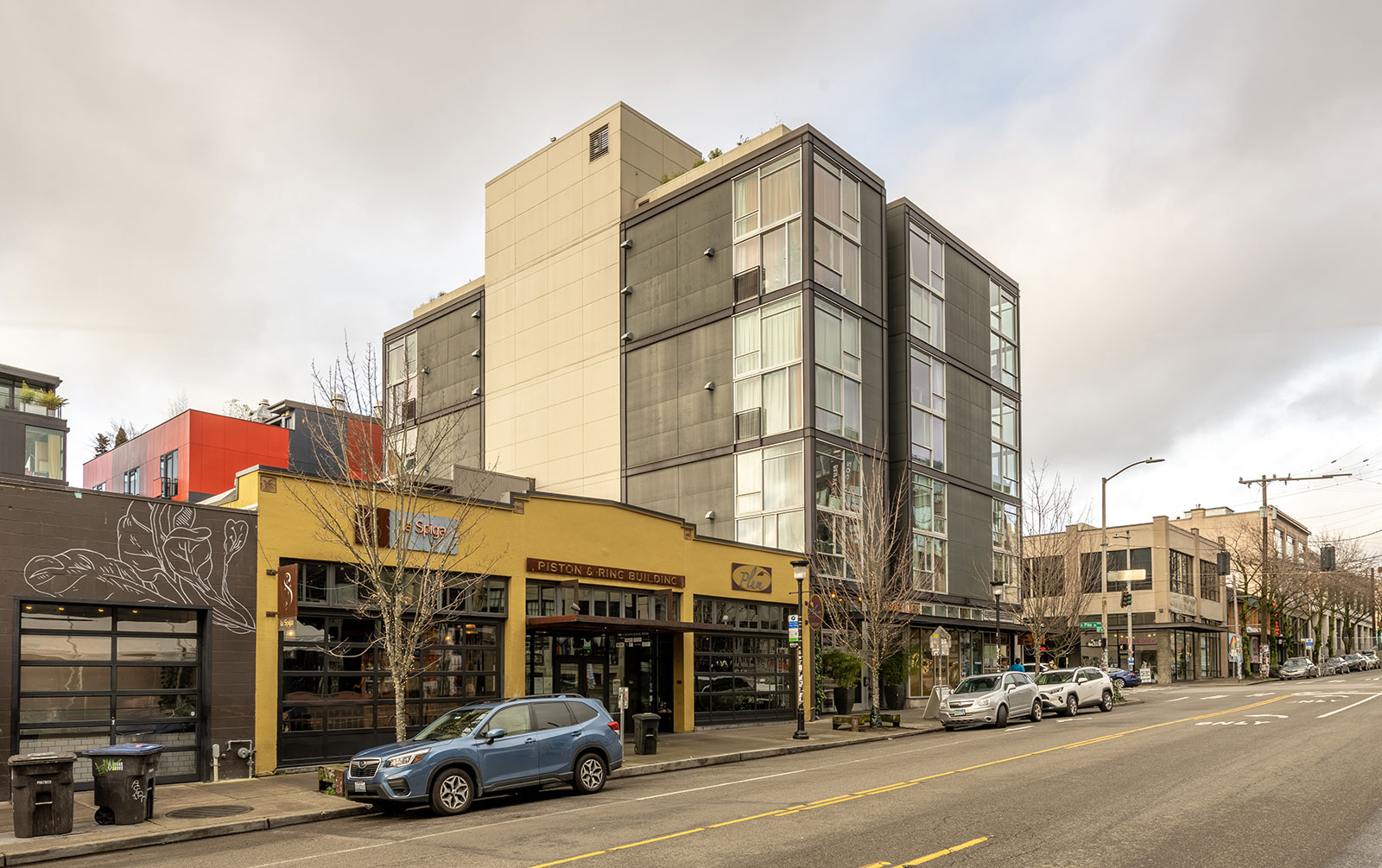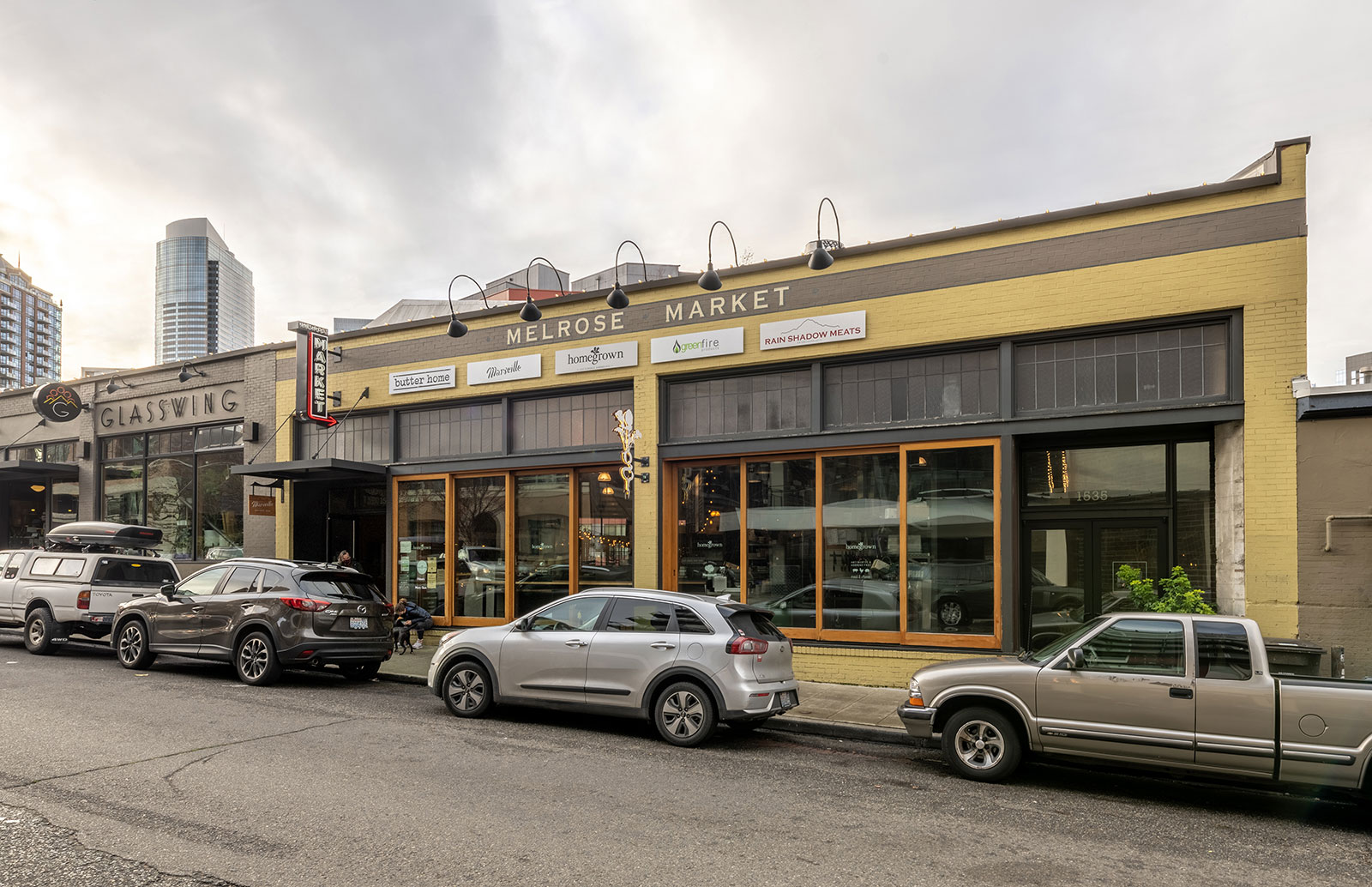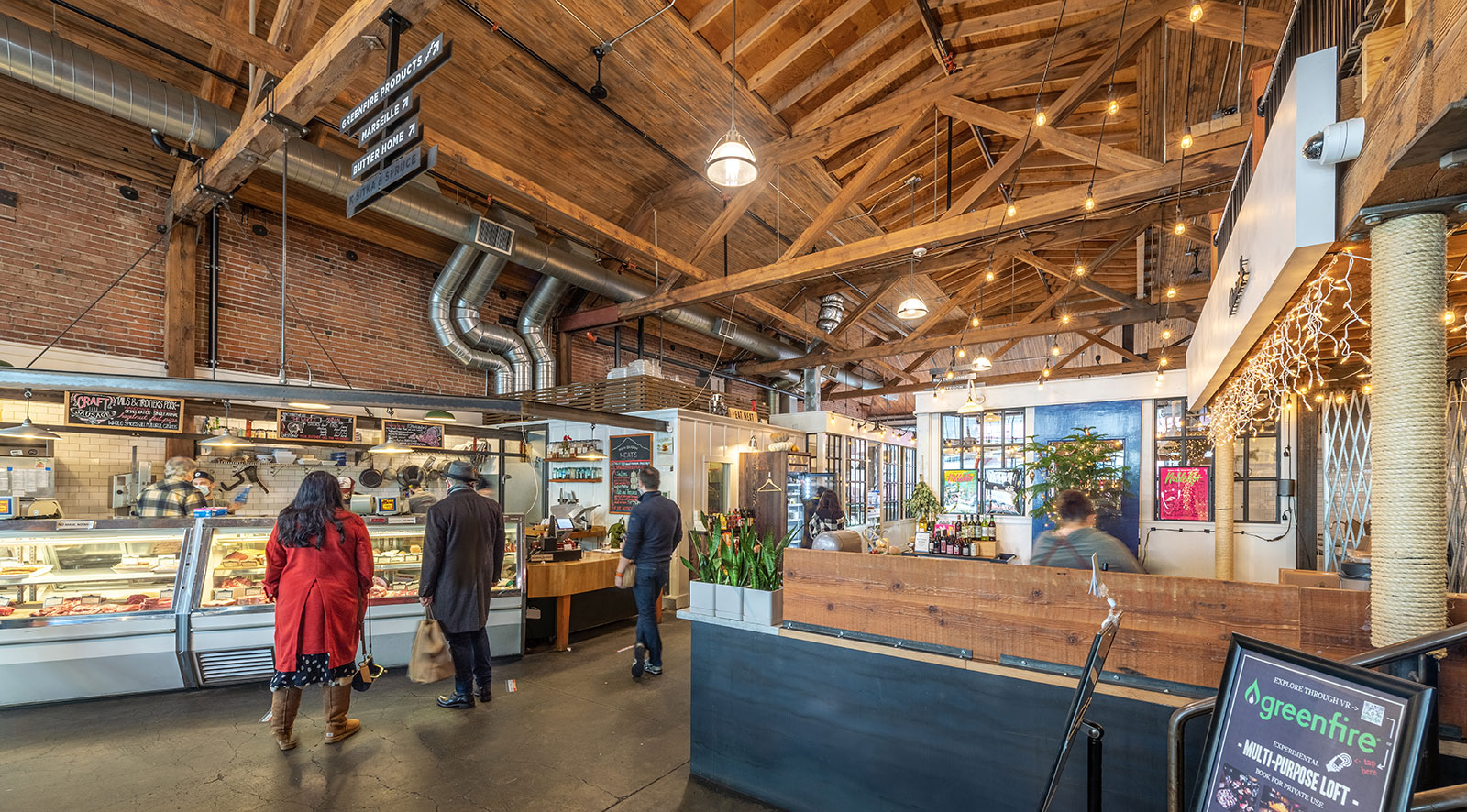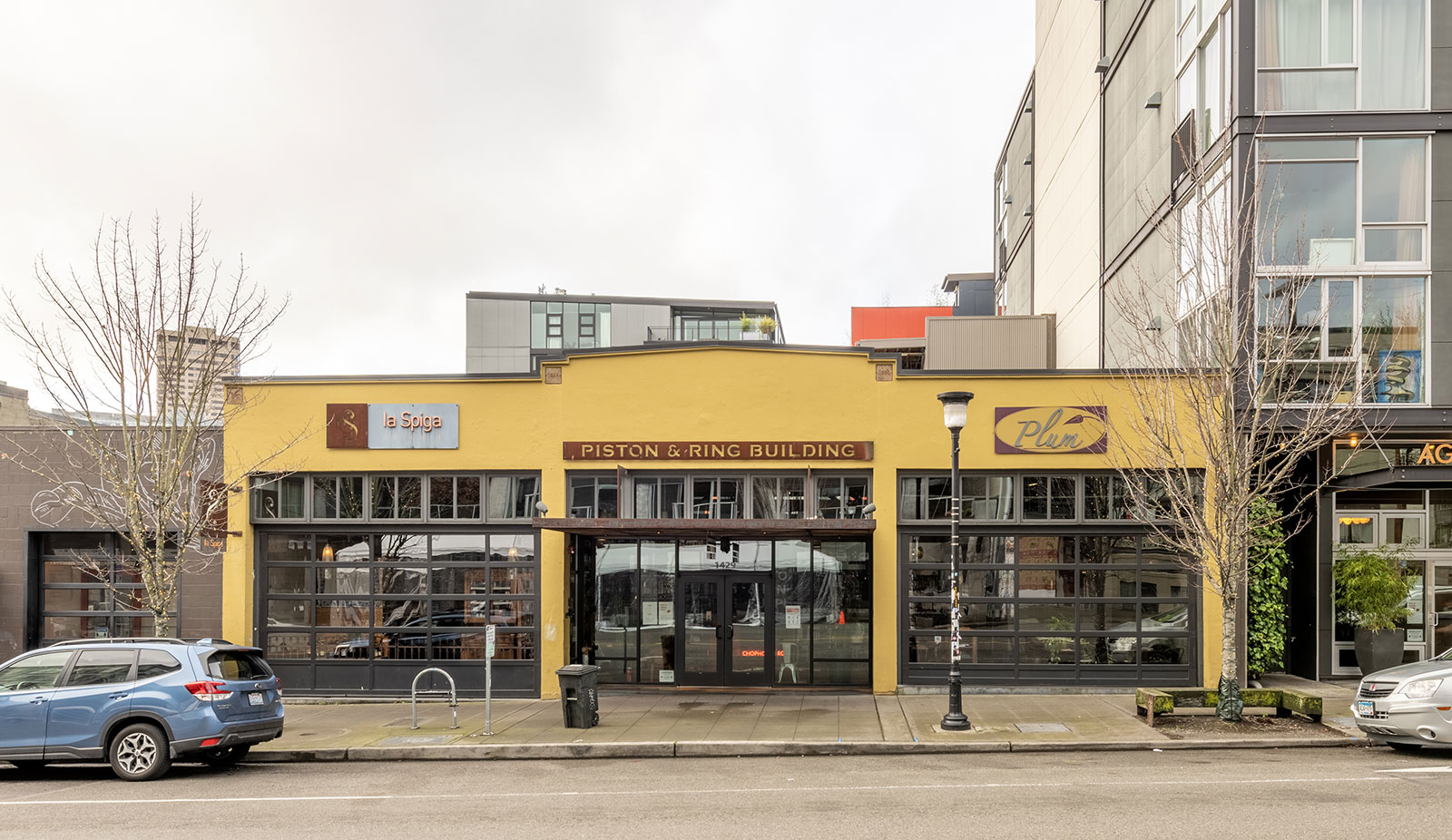A Conversation with Liz Dunn
by BUILD LLC

[Images by Andrew van Leeuwen]
In 2011, BUILD sat down with the forward-thinking Seattle developer and entrepreneur Liz Dunn to discuss the importance of density — urban and suburban — adaptive reuse, and a deeper understanding of sustainability. A decade (and a pandemic) later, these topics are more relevant than ever as we begin to resuscitate our cities.
The work you do with your development company Dunn + Hobbs fosters “urban villages,” and focuses on infill projects and reusing old buildings along Seattle’s Pike-Pine corridor. You’ve created some wonderful places in town, including 1310 E. Union, the Piston & Ring Building, the sleek Agnes Lofts, Melrose Market [and Chophouse Row]. Tell us a bit about how this focus came about.
I started with one piece of land that no one else seemed to want. It was 3,200 square feet, which is smaller than most single-family lots in Seattle but zoned for six stories. I love skinny lots because they’re such an interesting urban challenge, and the completed projects can have such great visual impact. The development we had been seeing in Seattle wasn’t particularly inspiring, and skinny urban buildings can inject so much life into their blocks.
It was difficult to get the process going; my first project,1310 E. Union, was an exercise in bootstrapping—pooling some equity with friends and miraculously finding a lender. I teamed up with Dave Miller [Miller Hull Partnership] on the project, and neither of us had ever done an urban mixed-use project before. But that was probably a blessing because we weren’t hampered by pre-conceptions.
Development work is a treacherous business—what can be built all-too-often depends not on good intentions or talent, but on the financial market and the banking system’s willingness to lend. How do you maintain such a consistent level of quality in your projects?
Building trust with lenders is an incremental thing. The process needs to go smoothly, everyone needs to get paid, and the finished projects need to be good. And I think banks appreciate the positive press that comes with innovative projects that the community appreciates. After 1310, the same bank loaned money on a much larger assembly of properties and supported me in incrementally tackling the slices one by one, improving buildings, and filling in urban voids. I guess I’ve had good luck finding lenders who believe in the long-term value of these neighborhoods, and who understand that good urban infill isn’t a cookie-cutter product.
Your concern for the well being of a neighborhood seems rare for a developer.
Hopefully less rare lately. The old guard has moved over for a new generation of developers who are truly interested in urbanism. Traditionally, developers used a model based on paper profit rather than building in places they would live; they would gather the demographic information, but they didn’t really understand the dynamics of the neighborhoods they were developing.
I think there’s a new breed of developer working at a smaller scale because they’re building for themselves in the places they already live. And there’s also a demographic shift underway in terms of where and how a lot of people want to live. Developers and architects are creating places that they actually want to live in (and often do), so they care about characteristics like the sidewalk life, neighborhood character, independent retail, and having “eyes on the street.”
You’re speaking our language; do you think it’s possible for a developer to be intimately invested in a project and still be profitable at the same time?
Partly. It’s a question of timeframe. Traditional developers and institutional investors want a pro forma that shows an easy five to ten-year payback, and they often try to flip a project as soon as it’s finished. If you design and build a project in a location that you believe in — one that you know has durability and long-term appeal — and you can afford to hang onto it, the bigger profit will come later. I would also say that for lasting design relevance, you’re better off with a small site than a big one. Every neighborhood has a scale, and it’s really hard to make a crisp, enduring statement on an over-sized site where the same elements have to be repeated too many times—which is why those projects look like outdated sardine boxes from day one. Some banks and investors are finally coming around to this way of thinking. Though it would be nice if someone would set up a bank for people who do great adaptive reuse and nice skinny infill, and an equity fund to repeat this a few times within a neighborhood so that the benefits of the projects can play off each other.
Your mission statement about attracting more people to live and work in urban neighborhoods is inspiring, and it seems to be working quite well. How do you measure your progress and success?
One way I track progress or success is by the presence of other elements in a neighborhood that don’t belong to my projects but perhaps were inspired by work that I did or the planning we’ve put into place in these areas. The slow, incremental layering and evolution of a neighborhood is an important indicator of progress to me; the eclectic mix of adaptive reuse combined with modern infill that allows for a lot of local business opportunity—people milling around on the sidewalk day and evening, enough of them to support even more local businesses and great places to hang out. It’s a virtuous circle, until one day you know you’ve been too successful because the out-of-neighborhood developers with their bad, too-big projects turn up! It’s tricky.
One of the benefits of your work is more people walking around the Pike-Pine corridor rather than driving. Does it defeat the purpose when you create a neighborhood so cool that everyone wants to get in their cars and drive there?
Ideally, everyone would have their own urban village within walking distance of where they live so they wouldn’t need to drive to ours. I think that’s gradually happening in Seattle, but in the meantime, yes, we hear complaints about parking. The problem is, you can’t have this great walking environment — the cool old buildings, skinny infill, and clusters of retail and restaurants spilling out onto the street — and have parking in these buildings; it wouldn’t work economically for the owners, and we’d have gaping parking entries on every block. The Seattle Times did a big story on parking a few years ago in which I tried to explain that if we had put a lot of parking in the Pike-Pine corridor, the neighborhood wouldn’t be successful in all the ways that make people want to visit it, but the story only included one out of context sound bite.
You [were] involved with the Preservation Green Lab; what are the goals of this organization?
It’s a policy effort, kind-of a think-tank that I started for the National Trust in 2008. Rather than “preservation” in the traditional sense, the goal was to make the case that all of our old buildings are part of thriving urban environments and to give them an identity in sustainable urbanism. Many of these older buildings were built in a far more sturdy and adaptable way than contemporary buildings. And people love them—tenants, customers, visitors. We’re really just trying to retain old buildings not just as “historic” structures, but as buildings that are interesting and useful and constantly being adapted.
As someone who’s in the trenches of urban issues, do you see solutions to better bring an integration of old and new to the United States?
I think we need to get conservation out of the hands of the preservationists so that we’re not just considering the history of a building. The conversation needs to include adaptation and reuse. The Pike-Pine corridor provides a good example of a new policy to retain buildings, but not make them so precious that they’re unusable. We need a smaller grain model for preservation here in the United States.
We’re not big fans of the term “green”—what’s your take on it?
Oh, dear. I’m probably going to get myself in trouble for saying this because I work on lots of “green building” policy issues, but my personal definition of sustainability puts a lot more focus on neighborhoods of buildings, physical connectedness, social and economic opportunity, resiliency, and sustainable infrastructure. To me, sustainability means neighborhoods that fire on all cylinders. I don’t mean to pick on green building, but design schools are way too focused on green building technology and don’t see the forest for the trees, so to speak.
We couldn’t agree more. What are some new strategies that you’re applying to design and development?
I’m interested in new kinds of conservation overlays for neighborhoods that aren’t’ about bottling up the past but adapting into the future, helping this pencil-out for owners of older buildings by making adaptive reuse more flexible from a code perspective, and promoting policies that encourage public infrastructure investments for things like district heating systems in older neighborhoods. And policies for letting development capacity get moved around within a neighborhood so that reusing buildings doesn’t come with a penalty. In the Pike-Pine corridor, you now get a density bonus if you build on top of an existing building, rather than demolishing it, and we want to create a program that makes it possible to sell unused air rights. Again, if we can focus more on creatively reusing buildings, and offering incentives to do so, that’s a good thing.
Are you a fan of the urban planner and hero of ours, Jane Jacobs?
I know it’s cliché, but I’m a huge fan of Jane Jacobs. She’s still the smartest urban design person ever, even though she’s not with us anymore. You’re probably familiar with the website called walkscore.com, which rates the walkability of neighborhoods—we’ve talked about how they should create a version that includes all of the Jane Jacobs’ concepts about building age, diversity, and local businesses, and call it the Jane Score. They’ve promised me that they will get right on it.
What advice do you have for the next generation of architects coming up the ranks?
The next generation of architects is going to have to embrace the idea that there is glory in adaptive reuse. Architecture schools still set unrealistic expectations for young architects — namely, that success as professionals is about creating new icons — whereas I think the role of the architect is becoming more about adding a thoughtful new layer of design to something that already exists. The profession is becoming more about contextualism and urban infill. There is pride and visibility in that, and some architects are embracing this change more quickly than others.
How are the roles at Dunn + Hobbes divided between you and your business partner?
Well, my original partner was my dog, Hobbes, and he hasn’t been with us for a while.
That’s not the answer we were expecting. Sorry to hear about your dog.
In the early days, before I had a real office, Hobbes would be the reason I would get out of my pajamas—so I could take him for a walk. So to answer your question about roles, I guess he scheduled my meetings.
Is there anything we didn’t ask that you’d like to cover?
It’s important to make clear that I am both pro-density and pro-building-reuse—I think we can do both successfully within the same neighborhood. But policymakers seem to focus on making the most dense places even more dense—suburbia also needs density. So let’s spread the love.
 Liz Dunn holds an MSc in City Design and Social Sciences from the London School of Economics; an MBA from INSEAD (France), and a BMath in Computer Science from the University of Waterloo (Canada). Liz worked in a variety of software engineering and product development roles at Microsoft, Microsoft Europe, and DreamWorks Interactive, and as an independent consultant to several software and media clients before founding her real estate development company, Dunn & Hobbes LLC, in 1997. Her Seattle projects include Chophouse Row, Agnes Lofts, Melrose Market, and the Cloud Room, a co-working space, culture club, lounge and bar, and two affiliated businesses—Cloud Studios, a band practice facility, and the Overcast Room, a podcast recording studio.
Liz Dunn holds an MSc in City Design and Social Sciences from the London School of Economics; an MBA from INSEAD (France), and a BMath in Computer Science from the University of Waterloo (Canada). Liz worked in a variety of software engineering and product development roles at Microsoft, Microsoft Europe, and DreamWorks Interactive, and as an independent consultant to several software and media clients before founding her real estate development company, Dunn & Hobbes LLC, in 1997. Her Seattle projects include Chophouse Row, Agnes Lofts, Melrose Market, and the Cloud Room, a co-working space, culture club, lounge and bar, and two affiliated businesses—Cloud Studios, a band practice facility, and the Overcast Room, a podcast recording studio.
[Photo by Chase Jarvis]










